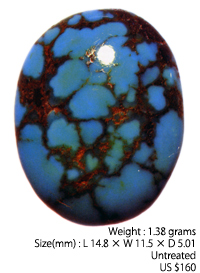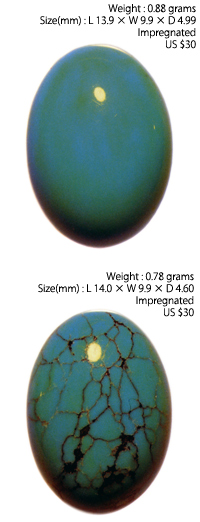COUNTRIES OF ORIGIN
The most important source of turquoise is the Nishapur mines in Iran, which produce large quantities of the highest quality material. Much of the turquoise from sources other than the Nishapur mines will become greenish or whitish within a year, even if it was a beautiful blue at the time it was mined. Therefore, turquoise stones are often impregnated with acrylics and other resins to prevent discoloration. Turquoise from the Sinai Peninsula can be superior in quality to the Nishapur material, but most of it is whitish and tends to break easily, while Mexican material has a characteristically dull color. |
 |
Iran (Persia)
The turquoise shown above, from Nishapur in Iran, was polished over 20 years ago, but it has maintained its naturally beautiful sky-blue color. Regarding the discoloration of turquoise, there are examples of royal crowns and scabbards from hundreds of years ago that are imbedded with dozens of pieces of turquoise that do not match in color. Assuming that the colors were matched at the time the stones were set, these differences can be attributed to the discoloration of the carious stones over several hundred years. Some pieces retained their color, while others turned greenish. It is an interesting phenomenon that different pieces if turquoise may or may not change color under the same conditions. |
|
Arizona
Turquoise from Arizona is less durable than the Persian material, with some material containing a spider web-like matrix. Arizona material is usually fashioned after being impregnated with a clear acrylic in its rough state, since much of the material will change color over time. |
 |
China
The majority of turquoise from China contains matrix and is dark in color. As with Arizona material, it tends to be fragile, so acrylic impregnation is usually necessary. Much of the material is green, and it is used in lower-priced pieces such as chokers. Most of the Chinese material is not very attractive. |
|
JUDGING QUALITY
First it is necessary to confirm whether the piece is a natural Persian stone or one that has been treated by impregnation with acrylics or the like. The quality scale to the next page consists of untreated Persian stones and impregnation-treated stones from Arizona. Untreated Persian material will be assigned one of the five grades from S to D, depending on beauty. In the chart to the right page, grades S, A, and B are untreated Persian turquoise, which are rarely seen in the marketplace. Because stones from Arizona and China will discolor and lose their beauty if left in their natural state, treatment is almost routine. In this book such stones are considered accessory quality and assigned a beauty grade of D.
Second, with regard to judging matrix, untreated Persian turquoise with well-balanced matrix is ranked in the same manner as comparable stones with not matrix. An unattractive matrix pattern, however, will lower the quality.
Finally, common deciding factors in the quality of both untreated Persian and acrylic-treated material are the presence of greenish hue, and the appearance of the stone. |
|